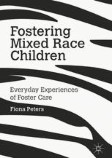Search
Search Results
-
“I Am a Mother, but Not a Mother”: The Paradox of Virtual Mothering
After I discovered an internet café for birth mothers in June 2005, I wrote a post, asking for participants willing to be interviewed. Only one...
-
Race and Market Values in Domestic Infant Adoption
In the realm of adoption in the United States, the demand for white1 infants exceeds their supply (Spar, 2006). The laws regulating private adoption...
-
The First Year in Care and the Matrix of Classifications
Stealth’s (age eleven) narrative reveals how the mixed classification within Children’s Social Care impacts on his care admission and his subsequent...
-
The Rise of the Databased Society
This chapter focuses on the business of buying and selling consumer, health and financial data, and the skewed bargains that most patients are faced...
-
Adoptive Parents e-Racing Adopted Children by Choosing, Kee**, Avoiding, and Purchasing Identity
New adoption research argues that we can no longer view transracial and transnational adoption as a completely benign process because these children...
-
Conclusion: Talking About Race and Adoption
Two years ago, on vacation in the Great Smoky Mountains, I saw a white couple at a restaurant with their Asian daughter. Although her father told her...
-
‘Someone’s Roots’: Gender, Rape, and Racialization in Korean American Adoption Narratives
Mei Lin, a Korean American adoptee who grew up in Minneapolis, spent a semester of college abroad at Yonsei University in Seoul, Korea. She did not...
-
Privileging Voices
It has already been established that the social studies of childhood regard children’s voices as credible and worthy of being listened to. Indeed,...
-
The Commodification and Online Marketing of Children in Transnational Adoption
The same global system that created inequalities in wealth among nations also created a globalized and systemic hierarchy of races by which the value...
-
Jewish Life on Campus: From Backwater to Battleground
The past two decades have witnessed a dramatic shift in the extent and focus of concerns about Jewish life on campus. The Jewish community is...
-
How Internationally Adoptive Parents Become Transnational Parents: “Cultural” Orientation as Transnational Care
Some of the most fundamental sites of caregiving are found in projects of kinship and family-making. Recent feminist scholarship reminds us to...
-
Introduction: Race Is a Fiction … Coloring Children and Parents Nonetheless
Race is a 15th century invention, born of a marriage between European imperialism and white-supremacist pseudo-science, meant to explain the reasons...
-
The Illusion of Autonomy: From Agency to Interdependency
This chapter explores the influence on research that the contemporary emphasis on children’s agency and autonomy has had and evaluates the usefulness...
-
Culture at Camp: White Parents’ Understanding of Race
Families are important conduits for learning about race. It is in families that many of our early notions of race and racial differences are...
-
Adoption in America
In 1851, when Massachusetts enacted a statue defining and regulating adoption, the United States became the first country in the world to recognize...
-
Safely ‘Other’: The Role of Culture Camps in the Construction of a Racial Identity for Adopted Children
Transnationally adopted children in the United States face a unique set of circumstances in which defining identity can be overwhelmingly difficult....
-
Setting the Danish Scene and Mixedness Concept
This chapter sets out to highlight the phenomenon of intermarriage in Denmark from a historical context, as well as by analysing current demographic...
-
The Construction of Imaginary Homelands
During my initial fieldwork in Copenhagen in June 2009, I was invited to a Korean-Japanese restaurant called Miga by two Danish-Korean adoptees,...
-
“No One Is More Swedish Than Me!”
In May 2010, during my initial fieldwork in Sweden, I met Cecelia in Stockholm. Cecelia, who was my first informant, is a researcher with a teaching...
-
Conclusions
Having concluded my journey into the Twilight Zone, I am well aware that I would never have come this far without the guidance of my informants whom...
